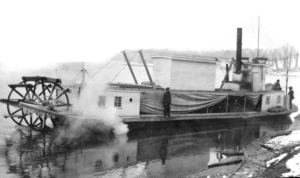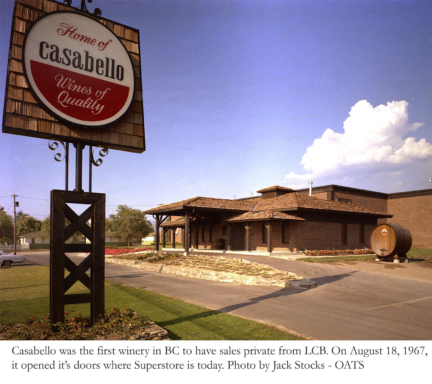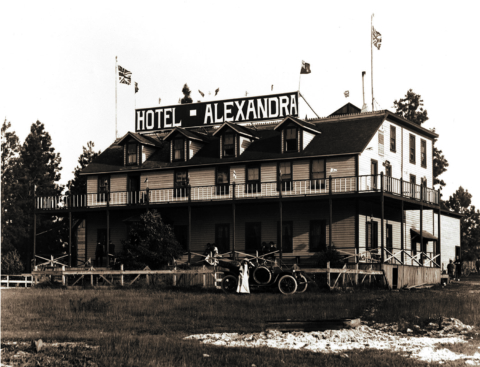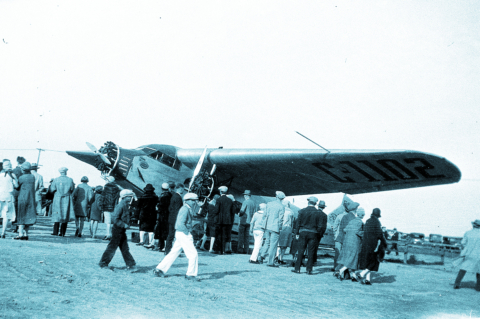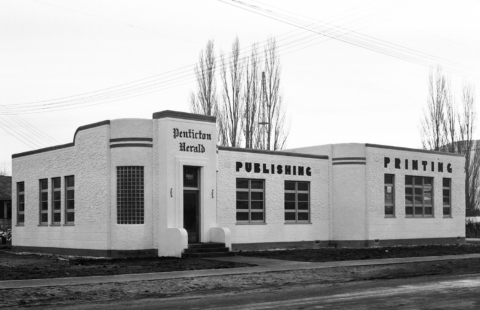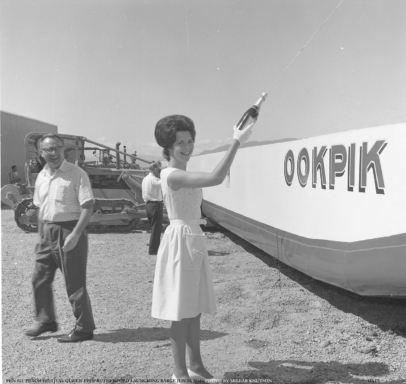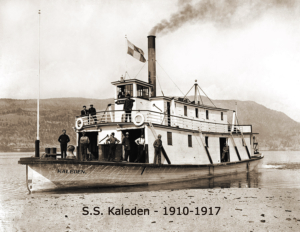
William Jessop Snodgrass was a City Councilor in La Grande, Oregon, in the heart of Union County.
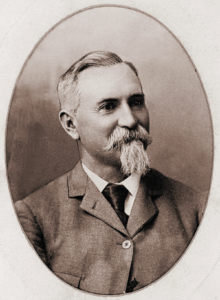
He ran a grist-mill, a mercantile, a freighting business, a steamship line, and had warehouses for miles along the Columbia. He had run for State Senator several times as well as being the Republican candidate for State Treasurer. He owned shares in The Columbia River and Blue Mountain Railway Co. which was to be absorbed by James Hill’s Great Northern in 1885. He was a vocal supporter of the Empire Builder, J.J. Hill and sat as a valued member of his railway syndicate.
When he arrived on the south shore of Dog Lake in 1892, his first thought was to build a boat. The only steamer running on Dog Lake at the time was Louis Holman’s little scow “Miramichi”.
Bill Snodgrass instantly entered into a partnership with Mr. Holman and Dr. Robert Mathison, the valley dentist. They became known as the “Dog Town Syndicate” and they set out to place the little engine from the Miramichi into a nicer hull built in Penticton, that they called the “Jessie”. But that wasn’t big enough and in 1893 they enlisted the Fireman from the S.S. Aberdeen, M.E. Cousins to build a sternwheeler at Okanagan Landing with a shallow enough draught to operate in the river oxbows between Penticton and Dog Lake. They named her the “Fairview” for obvious reasons, and she was captained by Louis Holman. At 55 feet long, she had constant problems in the narrow, shallow swamp of the Okanagan River; and when a she collided with a snag that demolished the wheelhouse and cast the captain overboard, it was decided to plead with the Government for help. Bill Snodgrass was given a $1500 Federal contract to remove snags from the Okanagan River in 1893.
This could be the Fairview but is unidentified
Snodgrass was doing so well with his steamboats, his general stores and his dray service that he wanted a really nice boat for his real estate investors to enjoy. When the “Fairview” caught fire in 1898, he ordered the “Maude Moore” from Ontario and put the engine from the “Fairview” into her. (Steam engines were very rare and expensive in the interior and Mr. Cousins seemed to be a bit of a genius in getting them to run after all kinds of disasters.) The “Maude Moore” turned out to be a real peach of a boat and the envy of all that sailed on her. When J.M. Robinson sailed on her in 1905, he made Mr. Snodgrass an offer he couldn’t refuse and ownership changed hands. She sailed between Summerland and Naramata for many years.
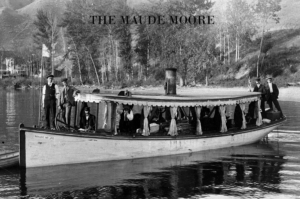
Snodgrass needed another freight boat with the burning of the “Fairview” so he sold the “Jessie” and used the money from both boats to build the sternwheeler “Greenwood” on the same design as the “Fairview”. But fire is the great equalizer, and she too burned.
W.J. Snodgrass’s plan for Okanagan Falls is another story, a story that crowns him the “Lord” of Dogtown. Bill left the area heartbroken after the death of his son, John, from a burst appendix. He chose to return to La Grande, Oregon without fulfilling his dreams and he died from a stroke October 14, 1909.
THE CPR STERNWHEELER KALEDEN AND THE MV YORK
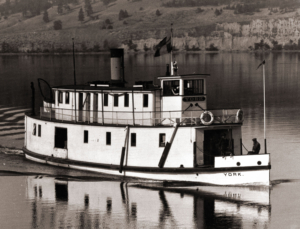
The York was originally destined to replace the tug “Victoria” on Trout Lake, north of Kootenay Lake during the Lardeau gold rush of the 1890’s. How she came to run on Dog Lake is quite a story.
Her 88-foot hull was pre-fabricated at Bertram Iron Works in Toronto in 1900, and shipped in pieces by train to Okanagan Landing, west of Vernon. She was re-assembled and launched on January 18, 1902. Here are her statistics: she was 138 tons gross, 88 feet long by 16 feet wide, with a draught of just over 4 ½ feet. She was a twin tunnel screw-drive with a wood burning two-cylinder 12.9 horsepower steam engine.
The York was originally captained by Joe Weeks, but that was short lived when he took over the Aberdeen in 1904, then the Sicamous in 1922 where he remained. Capt. Reid then took the helm of the York.
Originally the sternwheeler S.S. Kaleden (launched on July 3rd, 1910), was to service the route from Kruger’s Landing to Dog Town (Okanagan Falls). She was 94 feet long by 18.4 feet wide with a 4.6 ft draught. Even with her shallow draught, she just couldn’t navigate the oxbows between Okanagan Lake and Dog Lake. The York was called in to assist each and every attempt at navigation with the S.S. Kaleden. It is rumoured that the Kaleden only made one successful trip to the Falls and was never able to repeat it.
So, for the early inhabitants of Kaleden and Okanagan Falls, it was small boats or overland for all their freight. This continued until the Great War ended.
The York could only navigate the river during high water, so during the freshet of 1921, the S.S. York was transferred to Dog Lake to service the fruitland developments springing up around the Lake.
CPR chose to provide railcar barge service to the south rather than complete the rail line around the lake. A rail slip for a small barge was built at Kruger’s landing and another close to the Falls. The York pushed this barge and four railcars to the various landings. The wharf at Kaleden was not railed so fruit and goods were handled by hand carts. The York could push the barge directly onto the shore for deliveries to farms without wharves.
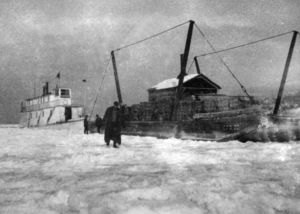
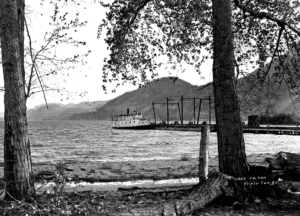
MV York on Skaha in winter Kruger’s Landing CPR Wharf 1930
The S.S. York continued to be a welcome sight on Skaha Lake until the KVR was completed around the lake in 1931. She was technically the property of the Kettle Valley Railway, having been sold to the corporation for $20,000 in 1920. She was taken out of service in 1932 and sold. She was dismantled and shipped to Nakusp but never reassembled. An era had ended.
THE SMALL BOATS OF SKAHA LAKE
After the fiery demise of the “FAIRVIEW” and the “GREENWOOD” and the sale of the “MAUDE MOORE”, there was a short gap in providing lake service to Dog Lake communities.
The lower wagon road around the lake was dependant on the weather and continual maintenance. Many trips to the southern mines had to turn off and go the over the sand hill track to Twin Lakes and through Willowbrook to Fairview. This was a day longer with fewer changes of teams along the way.
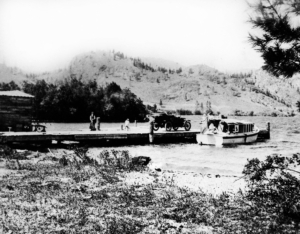
The Mallard at Okanagan Falls Wharf 1914
In 1909, James Ritchie purchased C.N. Higgins yacht “MALLARD” to haul freight to his new subdivision at Marron Creek that he called “Kaleden”. It was natural for him to change the name to the “KALEDEN”. It was simply good advertising.
By 1911, Kaleden was in financial trouble so Ritchie sold the “KALEDEN” to J. Fraser-Campbell and Seaman Hatfield (Kaleden Postmaster). The little boat was slow and heavy and proved difficult in the oxbows. They soon sold her and purchased a forty-foot gas launch, the “CYGNET”.
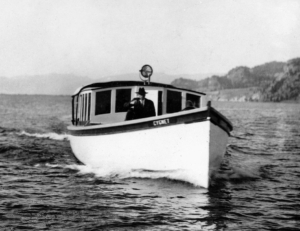
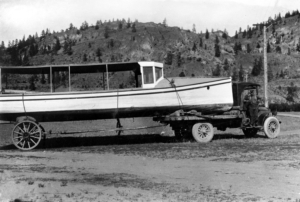
The Cygnet The Mallard II
These enterprising partners established the South Okanagan Transportation Company and in 1914 launched “MALLARD II”. This little 32-foot, gas driven tunnel screwdrive yacht was much faster and made several trips a day on the lake. The “MALLARD II” was sold in 1920 to Bassett’s Freight Lines and moved to Osoyoos Lake.

